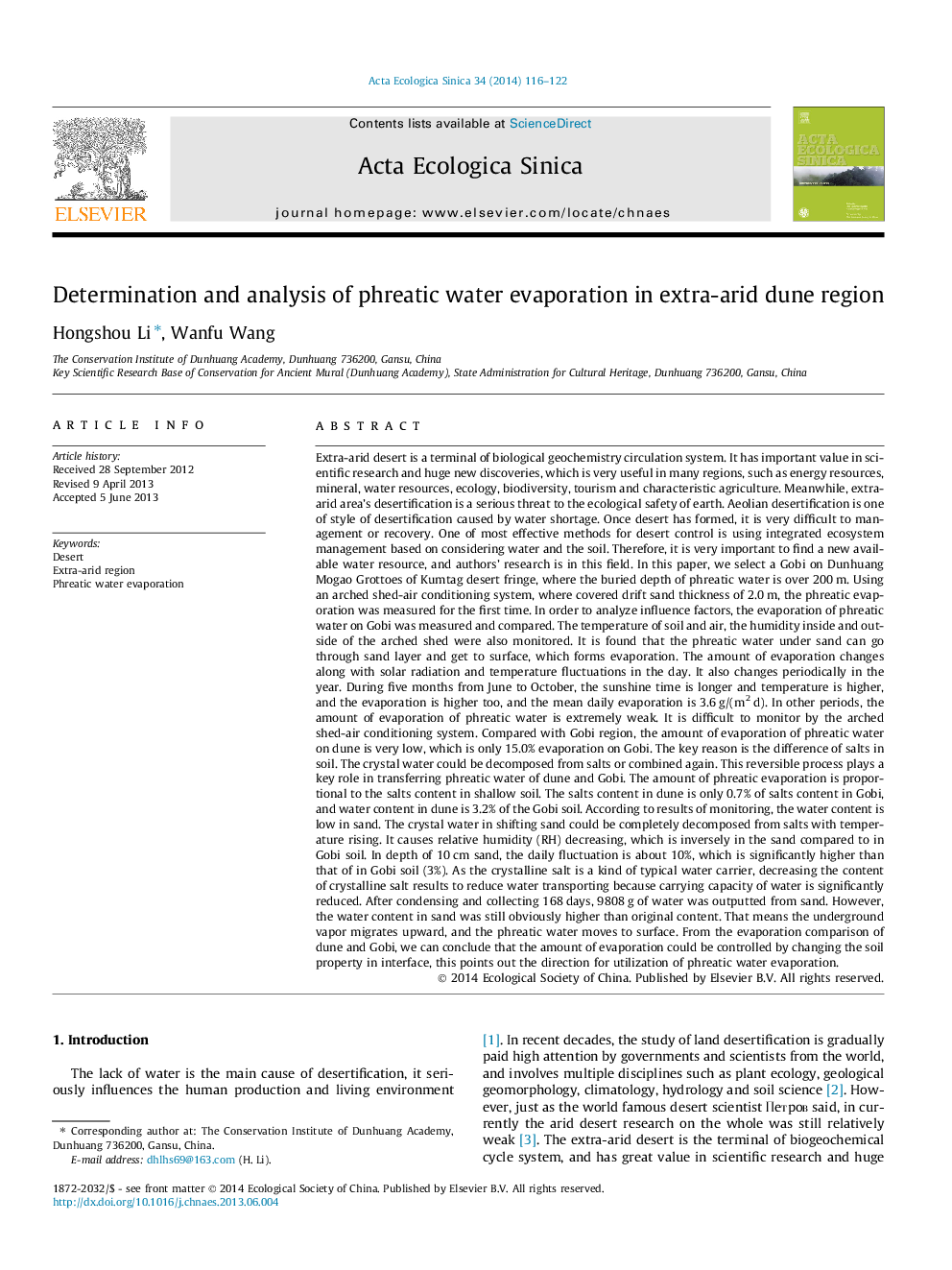| کد مقاله | کد نشریه | سال انتشار | مقاله انگلیسی | نسخه تمام متن |
|---|---|---|---|---|
| 4379990 | 1303956 | 2014 | 7 صفحه PDF | دانلود رایگان |
عنوان انگلیسی مقاله ISI
Determination and analysis of phreatic water evaporation in extra-arid dune region
ترجمه فارسی عنوان
تعیین و تجزیه و تحلیل تبخیر آب فرایا در منطقه خلیج فارس
دانلود مقاله + سفارش ترجمه
دانلود مقاله ISI انگلیسی
رایگان برای ایرانیان
کلمات کلیدی
کویر، منطقه خشک و خشک، تبخیر آب فریتا،
موضوعات مرتبط
علوم زیستی و بیوفناوری
علوم کشاورزی و بیولوژیک
بوم شناسی، تکامل، رفتار و سامانه شناسی
چکیده انگلیسی
Extra-arid desert is a terminal of biological geochemistry circulation system. It has important value in scientific research and huge new discoveries, which is very useful in many regions, such as energy resources, mineral, water resources, ecology, biodiversity, tourism and characteristic agriculture. Meanwhile, extra-arid area's desertification is a serious threat to the ecological safety of earth. Aeolian desertification is one of style of desertification caused by water shortage. Once desert has formed, it is very difficult to management or recovery. One of most effective methods for desert control is using integrated ecosystem management based on considering water and the soil. Therefore, it is very important to find a new available water resource, and authors' research is in this field. In this paper, we select a Gobi on Dunhuang Mogao Grottoes of Kumtag desert fringe, where the buried depth of phreatic water is over 200Â m. Using an arched shed-air conditioning system, where covered drift sand thickness of 2.0Â m, the phreatic evaporation was measured for the first time. In order to analyze influence factors, the evaporation of phreatic water on Gobi was measured and compared. The temperature of soil and air, the humidity inside and outside of the arched shed were also monitored. It is found that the phreatic water under sand can go through sand layer and get to surface, which forms evaporation. The amount of evaporation changes along with solar radiation and temperature fluctuations in the day. It also changes periodically in the year. During five months from June to October, the sunshine time is longer and temperature is higher, and the evaporation is higher too, and the mean daily evaporation is 3.6Â g/(m2Â d). In other periods, the amount of evaporation of phreatic water is extremely weak. It is difficult to monitor by the arched shed-air conditioning system. Compared with Gobi region, the amount of evaporation of phreatic water on dune is very low, which is only 15.0% evaporation on Gobi. The key reason is the difference of salts in soil. The crystal water could be decomposed from salts or combined again. This reversible process plays a key role in transferring phreatic water of dune and Gobi. The amount of phreatic evaporation is proportional to the salts content in shallow soil. The salts content in dune is only 0.7% of salts content in Gobi, and water content in dune is 3.2% of the Gobi soil. According to results of monitoring, the water content is low in sand. The crystal water in shifting sand could be completely decomposed from salts with temperature rising. It causes relative humidity (RH) decreasing, which is inversely in the sand compared to in Gobi soil. In depth of 10Â cm sand, the daily fluctuation is about 10%, which is significantly higher than that of in Gobi soil (3%). As the crystalline salt is a kind of typical water carrier, decreasing the content of crystalline salt results to reduce water transporting because carrying capacity of water is significantly reduced. After condensing and collecting 168Â days, 9808Â g of water was outputted from sand. However, the water content in sand was still obviously higher than original content. That means the underground vapor migrates upward, and the phreatic water moves to surface. From the evaporation comparison of dune and Gobi, we can conclude that the amount of evaporation could be controlled by changing the soil property in interface, this points out the direction for utilization of phreatic water evaporation.
ناشر
Database: Elsevier - ScienceDirect (ساینس دایرکت)
Journal: Acta Ecologica Sinica - Volume 34, Issue 2, April 2014, Pages 116-122
Journal: Acta Ecologica Sinica - Volume 34, Issue 2, April 2014, Pages 116-122
نویسندگان
Hongshou Li, Wanfu Wang,
